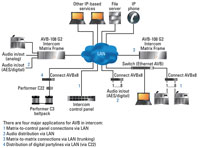Intercom design
Today's intercom systems are quite different from those installed only a decade ago. What may have been an analog partyline system in the 1990s has evolved into digital partyline and matrix-based solutions. Additionally, today's high-speed, high-technology and sometimes high-risk productions demand ever more sophisticated and complex communications. Directors, TDs and crews must have reliable, portable and flexible intercoms. This article presents an overview on current intercom requirements and design trends while offering tips for technology selection.
Beyond the intercom
Contemporary intercom systems must be able to handle different scenarios, including OB settings like this one inside a Touring Video OB truck.
The demands placed on contemporary intercoms are as diverse as the installations where they are used. Scenarios include large production facilities with hundreds of users (maybe even with connections to remote production sites), as well as small studios or temporary OB systems with constantly changing configurations.
Besides a system's scalability for allowing the maximum usage for a large range of users, the amount of possible integration with facility technology is pivotal to an intercom system's ergonomics. Here, integration refers to the mixing of various signal types as well as various technologies and protocols.
Regarding the signal side of today's intercom systems, communication is more than just a simple link between two people. In addition to voice, analog and digital audio signals, data and control signals also need to be interfaced and managed. How an intercom system handles different signal types and integrates them is an extremely accurate indicator of its usefulness.
Integration can be understood in two different ways. One aspect is the kind of signal that can be handled. The other aspect relates to the interfacing side — how the system transmits the combined signals, and what transmission protocol is used.
The professional video industry's #1 source for news, trends and product and tech information. Sign up below.
In today's landscape, newer intercoms rely on digital audio for communication. This makes it easy to combine that audio with an AES3 and MADI-centric communications infrastructure. This allows facility designers to integrate equipment like digital audio routers seamlessly with the intercom system. Incorporating these signals into the matrix offers several advantages.
First, digital itself brings a lot of flexibility to the facility design, especially when it comes to integrating other equipment into the communications infrastructure. Second, relying on non-proprietary standards like AES3 and MADI opens the door to many options in facility design. Finally, a data-centric system enables the support of additional features such as embedded general purpose input outputs (GPIOs).
More than point-to-point
Modern broadcast and production environments often require the use of a variety of tools, such as analog and digital professional radios, partyline systems and wireless handsets.
The way an intercom system handles these outside signals is crucial to the overall systems' flexibility. And, any new intercom platform should also be able to interface with other broadcast equipment to facilitate workflows and, for example, integrate production signals like program feeds.
For handling connections over large distances, say, between a production facility and a remote studio, VoIP connections are a good solution. Session Initiated Protocol (SIP)-based technology supports the EBU Tech 3347 standard, which allows for connections to remote systems and integrates them into a single infrastructure. The only downside to using VoIP technology is that it does not provide real-time communication. However, broadcast applications are more concerned with connectivity rather than minimal latency (perhaps a few tens of milliseconds) that may occur with VoIP.
Audio/video bridging

Figure 1. This shows a block diagram of an AVB-based network. In addition to providing full intercom features, the network can intermix multiple vendors, control a range of non-intercom equipment and protect program content channels via IEEE 802.1Qat.
A current intercom trend is to leverage the same technology used to deliver content for communication. Audio/video bridging (AVB) is an Ethernet-based technology that allows the use of a single infrastructure to transport multiple types of signals over the same network backbone. AVB permits both data communication and content audio to travel over an AVB-compliant network.
AVB makes use of several IEEE standards, including the following: IEEE 802.1AS: Timing and Synchronization for Time-Sensitive Applications (gPTP); IEEE 802.1Qat: Stream Reservation Protocol (SRP); IEEE 802.1Qav: Forwarding and Queuing for Time-Sensitive Streams (FQTSS); and IEEE 802.1BA: Audio Video Bridging Systems.
A key component in these standards is IEEE 802.1Qat, which provides a mechanism for bandwidth reservation. Contrary to common QoS schemes, 802.201Qat provides a reliable mechanism of reserving bandwidth for each audio or video stream. (See Figure 1.)
Any potential hazard regarding network overload is avoided through bandwidth management, which means identifying and denying streams that might exceed a network's capacity. It is also possible to reserve a portion of the available bandwidth for non-AVB traffic. This allows AVB devices to share the same cabling and infrastructure with non-AVB devices like network monitoring or control systems.
A protocol for device discovery, enumeration, connection management and control is currently undergoing the final phase of standardization and is due to be released soon. This protocol, IEEE 1722.1, will allow for easy integration of AVB into a broadcast workflow and facilitate interoperability between devices of different manufacturers.
This capability means new options for intercom and infrastructure design. The flexibility will permit control panels to be added at any point in the system just by connecting them to an Ethernet port. AVB effectively eliminates the need for dedicated cabling for intercoms, thereby reducing cabling costs.
Despite the potential for overall increased network complexity, the time required to set up communication networks will be reduced because only one network needs to be installed. Furthermore, AVB offers the possibility to use hardware from multiple manufacturers together on a single network.
This design approach means simpler intercom installation, with expanded features, operating on a unified network. The real plus is that both communications and content can safely reside on a single and reliable IP network.
Christian Diehl is product manager, intercoms, Riedel Communications.
